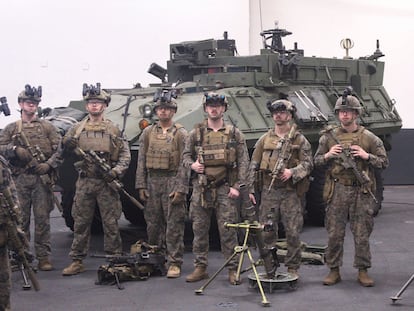A message from Gaza’s hospitals: ‘This isn’t a movie, we’re losing patients every minute’
Only 14 of the 36 hospitals in the Strip are partially operational, according to the WHO. A Médecins Sans Frontières doctor and a medical student share their frustration at the magnitude of the emergency
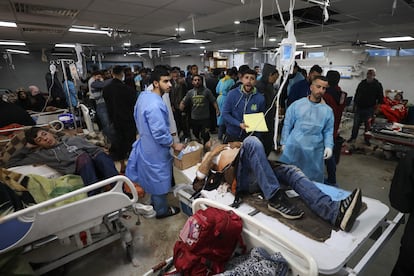

“I don’t know how I feel. It’s a mix of frustration, depression, anxiety. We don’t have a sense of being alive. We are just machines trying to make the days go by one by one.” Ruba, a doctor with Médecins Sans Frontières (MSF), responds to this newspaper’s questions using voice messages that she has difficulty sending due to the unstable and precarious connections in Gaza.
Until October 7, the day on which the offensive began, the doctor, who does not want her full name to be published, was working with MSF treating traumatology patients in Khan Younis, in the south of the Strip. Now, relocated in Deir al-Balah, in the center of the Palestinian enclave, she is treating the wounded and performing treatment using first aid equipment provided by the NGO. On January 6, MSF evacuated its staff from Al-Aqsa hospital for security reasons — a medical center that is still partially operational, despite the scarcity of personnel and materials and the proximity of the bombardment.
“In recent weeks it was very difficult to get any kind of connection and the Palestinian Red Crescent couldn’t work out where the shelling was taking place, where the wounded were and how to bring them to the hospital, the only one that is still partially functioning in this city,” explains Ruba.
The doctor lives in a small rental apartment in Deir al-Balah, after being forced to leave her home in Beit Hanoun, in the north, during the first days of the bombings. Thirty people from the same family, half of them children, are crammed into two rooms. “I still think those who died in the first few days were the lucky ones. We never imagined that this would last this long. We’re now in the fourth month, the war goes on and no one cares about the Palestinians, our children, our pain,” says the 32-year-old doctor, who has a son and two daughters aged seven, six and two years old.
Those who died in the first few days were the lucky ones. We never imagined that this would last this longRuba, doctor with Médecins Sans Frontières (MSF)
In recent days, Palestinian journalists, local NGOs and witnesses have spoken of shelling in close proximity to the Al-Aqsa hospital area. “There is a shortage of beds, equipment, staff and access to the hospital is really difficult. A week ago the tanks were very close. Imagine a hospital with 7,000 people, including patients, staff and evacuees, who fled their homes seeking refuge there and now they have to leave again,” adds Ruba.
Israeli attacks have now claimed the lives of more than 26,000 Gazans since October 7, when members of the Palestinian Islamist movement Hamas, which effectively rules Gaza, staged an unprecedented attack on Israeli territory, killing some 1,200 people and kidnapping more than 200 others. In addition, the number of wounded in the Strip exceeds 65,000, according to figures from the regional Ministry of Health.
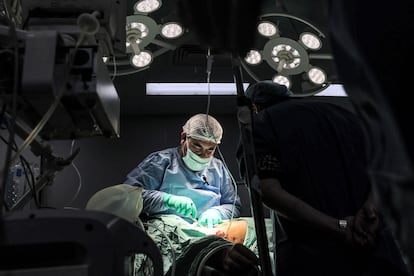
“A few days ago, my son asked me: ‘Mom, can we leave Gaza now? I just want to go.’ Imagine being asked that question by a 7-year-old, telling you that he just wants to live,” says Ruba. “He told me: ‘I’m scared that the tanks will come close, that we won’t be able to get food or water, that we’ll starve, I’m scared that you’ll die in my arms, Mom, because someone will shoot you, the helicopters will shoot you, and we can’t save you,’” explains the MSF doctor.
Without rest
Ibrahim also prefers his last name not to be published. This young man is in his fifth year of medical school, but since the beginning of the Israeli military attack he has been working non-stop at Al-Aqsa hospital, in the orthopedic surgery department, where he arrived as a volunteer when the bombing began.
“I never imagined having to practice in this way even before I finished my studies, but there was a need for doctors,” he says. This 20-year-old Gazan rarely gets to leave the hospital. He eats, sleeps and works inside. His family has moved to the south, facing great hardship and sleeping in the street at times, and he longs for news of them. Communicating with Ibrahim is also very tricky, largely due to the connection outages that the Strip has been experiencing, which in some cases have lasted for days. When he reappears, his messages are telegraphic, sometimes accompanied by a photograph showing minor operations, extractions of bullets or dressings of shocking wounds infected from a lack of care. Most of the images show patients on the floor as he kneels before them, working.
I never imagined having to practice in this way even before I finished my studies, but there was a need for doctorsIbrahim, medical student
“I’m still alive,” he says by way of greeting. “But it’s getting worse every day. The hospital is still functioning, only at half strength, with a severe lack of personnel and equipment. We have the bare minimum. This isn’t a movie, we’re losing patients every minute,” Ibrahim adds.
—How many patients are arriving at the hospital each day?
—“Many, too many.”
—Dozens?
—“There have been terrible days when there were several hundred.”
According to the World Health Organization (WHO), of the 24 hospitals in the northern part of Gaza, only seven are still open, but they are working with insufficient staff, equipment and fuel. Of the 12 medical centers in the south, only seven are still partially functioning. The United Nations (UN) has expressed its concern over reports of military raids on some medical centers, arrests of medical personnel, burial pits in the courtyards of clinics, shelling in the vicinity of these hospitals and the wounded being denied access to even the most basic care.
The painful decision to evacuate
Carolina López, MSF’s emergency coordinator, worked for several weeks at Al-Aqsa hospital, along with some 50 MSF workers. “There was an average of 700 hospitalized patients. The day we received the fewest wounded was around 40. On December 28 there was a peak and 300 people arrived. There were also people seeking shelter from the bombs in the hospital area,” she explains to this newspaper, confirming Ibrahim’s testimony.
On January 4, the evacuation of the hospital began. The front was advancing, Israeli tanks were two kilometers away from the medical center and patients, displaced persons and medical staff began to leave. MSF also decided to pull out of the medical center because it could no longer guarantee the safety of its staff and the rotation of its teams.
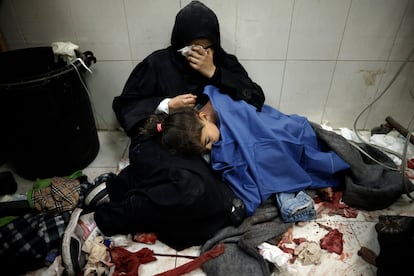
“Leaving your patients is such a tough decision, but we had no choice,” López says sadly. “The hospital lost its capacity without us, of course, although it also went from having 700 patients to about 140, those who could not leave. But there were other wounded patients who kept coming and are still coming, because it is the only hospital in that area,” adds the Spanish worker, before stressing that in 17 years of experience in emergency care “I never imagined” experiencing such an extreme situation.
A WHO mission gained access to the hospital in Deir al-Balah in mid-January and found that only 12 doctors were still working there, equivalent to 10% of its staff
López has maintained some contact with a couple of doctors who stayed behind at Al-Aqsa Hospital after the evacuation. “They did it assuming all the consequences, knowing that they were running a huge risk, because we have seen what has happened in other hospitals,” she says. A WHO mission gained access to the hospital in Deir al-Balah in mid-January and found that only 12 doctors were still working there, equivalent to 10% of its staff.
The emergency coordinator stresses the role of Gaza’s health workers, who “are exhausted and haven’t stopped for over 100 days.” López explains that those who have families leave for work, risking their lives to get to the hospital, and do not know what will happen to their children while they are gone. And those without immediate family or those who have settled in Rafah, in the southern end of the Strip, return to the hospitals and work tirelessly for days at a time. “The conditions are terrible, you have to be there to understand it,” she concludes.
Last weekend, MSF reported that the Nasser Hospital, the most important hospital still operating in Gaza, located in Khan Younis, in the south, is barely operational due to heavy fighting and shelling in the area, which forced most of the patients, refugees and medical staff to flee the area. Between 300 and 500 wounded people remain at the hospital who could not be evacuated due to their serious condition. “Nasser’s surgical capacity is now virtually non-existent and the few medical personnel remaining at the center have to cope with the situation with scant supplies, insufficient to deal with major influxes of casualties,” warned the NGO.
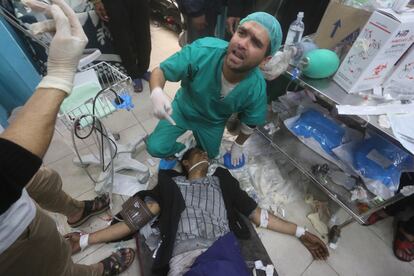
Sign up for our weekly newsletter to get more English-language news coverage from EL PAÍS USA Edition
Tu suscripción se está usando en otro dispositivo
¿Quieres añadir otro usuario a tu suscripción?
Si continúas leyendo en este dispositivo, no se podrá leer en el otro.
FlechaTu suscripción se está usando en otro dispositivo y solo puedes acceder a EL PAÍS desde un dispositivo a la vez.
Si quieres compartir tu cuenta, cambia tu suscripción a la modalidad Premium, así podrás añadir otro usuario. Cada uno accederá con su propia cuenta de email, lo que os permitirá personalizar vuestra experiencia en EL PAÍS.
¿Tienes una suscripción de empresa? Accede aquí para contratar más cuentas.
En el caso de no saber quién está usando tu cuenta, te recomendamos cambiar tu contraseña aquí.
Si decides continuar compartiendo tu cuenta, este mensaje se mostrará en tu dispositivo y en el de la otra persona que está usando tu cuenta de forma indefinida, afectando a tu experiencia de lectura. Puedes consultar aquí los términos y condiciones de la suscripción digital.
More information
Archived In
Últimas noticias
Most viewed
- Reinhard Genzel, Nobel laureate in physics: ‘One-minute videos will never give you the truth’
- Oona Chaplin: ‘I told James Cameron that I was living in a treehouse and starting a permaculture project with a friend’
- Pablo Escobar’s hippos: A serious environmental problem, 40 years on
- Chevy Chase, the beloved comedian who was a monster off camera: ‘Not everyone hated him, just the people who’ve worked with him’
- Why we lost the habit of sleeping in two segments and how that changed our sense of time
